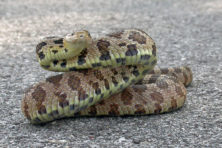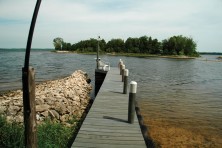DOOR TO NATURE: Snake Sense
- Share
- Tweet
- Pin
- Share

Many people have phobias, such as arachnophobia, the fear of spiders; or acrophobia, the fear of heights. The fear of reptiles and amphibians is called herpetophobia. Herpetology is the study of snakes and other reptiles and amphibians. It is derived from the Greek word “herpeton,” which means “creeping thing.”
All of us in northeastern Wisconsin can feel safe because there are no native venomous snakes in our part of the state, and, as I have seen on my hikes in parks and preserves, most snakes try to get away from people as quickly as they can. For example, while I was leading a hike at Toft Point in the middle of May, we were near the shore of Mud Bay and saw a northern water snake moving away from us rather quickly.
Of all the snakes one could see in our area, this is the most cantankerous of the bunch. It can grow to be three to four feet long and prefers to live in and near water. To that end, its scales are more heavily keeled than those of many other snakes, with a distinct raised ridge in the center to help it glide through the water.
Northern water snakes do not like to be handled, so they toss and twist with great strength when held and can bite the holder to get released. If you encounter one on a trail and it can’t escape easily, it will coil and lunge at you with its mouth wide open, showing the white lining. That’s why some people think it’s a cottonmouth.
One of the most wonderful snakes to handle – offering quite the opposite experience – are red-bellied snakes. They are found throughout much of the Upper Midwest, grow eight to 10 inches in length, are slender, and seem to enjoy the warmth of your hand, especially on a chilly day. I remember the first one I saw – on a hike with a class at Toft Point about 45 years ago. It was a cold, autumn day, and when I picked up this timid creature, it wound its way between my fingers to soak up some heat.
Another small, easy creature to handle is the DeKay’s brownsnake, a widespread reptile in this part of North America. They range in length from nine to 13 inches and are known to migrate during the spring and fall.
The red-bellied snake and brownsnake have specialized jaws and teeth that can pull land snails out of their shells, and slugs and earthworms are part of their diet as well. The brownsnake hides during the day and searches for its food at night.

One of the most common and frequently seen snakes is the western fox snake. Some people call it a pine snake, but the true pine snakes live in the southeastern part of North America. Fox snakes’ average length is three to four and a half feet, and the longest recorded was five feet, 10 inches.
They have a rusty-brown head, and, if disturbed, they may shake their tail among dry leaves. These features make some people think they’ve found a copperhead or a rattlesnake. Fox snakes are able to climb trees and sometimes get into nests to eat bird eggs or young birds, but they are valuable to farmers and orchard owners because of the large number of destructive rodents they eat.
It’s surprising how they can consume creatures that are larger than the diameter of their head. This is possible because their lower jaw is divided into two sections that are connected by an elastic tissue. Each part of the lower jaw is attached to the upper jaw in a way that allows great freedom of movement to surround the object being ingested, and inward-curving teeth help this procedure.

The ring-necked snake is not seen as commonly as many others because this secretive reptile hides during the day and hunts at night. It averages a foot in length and is found in the northern half of Wisconsin and most of Michigan. Its diet consists of worms, small snakes, frogs and salamanders.
A species that’s widespread throughout the Midwest and seen frequently is the common garter snake. It ranges in length from 18 to 20 inches, and the longest one on record is four feet. It has green and yellow markings that can vary quite a bit. These snakes also move quickly to escape. If you catch one, it may try to bite, but more often, it releases a malodorous substance from glands near the tail. The smell is almost bad enough to make you instantly release it.
Snakes reproduce by laying eggs or by giving birth to live young, but fewer than half of snakes in the U.S. bear live young. Those bearing live young are the copperheads, rattlesnakes, cottonmouths and, in our area, brown, garter and water snakes.
When eggs are laid, they need to be in a warm, moist environment because exposure to sun and dry air kills the embryos inside. In some species, the young come out of their rubbery shells in just four days, but in other species, this takes several months. Many snakes are born in late summer or early autumn, and some species take several years to mature.
Snakes have fine senses of sight and smell. In fact, their eyes never close, even while sleeping. A clear membrane covers the eyes and is removed during the periodic shedding of the creature’s skin.
Learn all that you can about these valuable creatures, which are an important part of our natural environment, but let them go on their way to remain one of nature’s wild partners.


